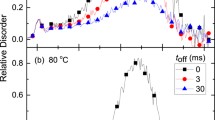Abstract
We have observed efficient damage recovery in large-scale molecular dynamics simulations of 30 keV Zr recoils in pure zirconia and yttria-stabilized zirconia, which is in stark contrast to radiation damage accumulation in zircon. Dynamic annealing is highly effective in zirconia during the first 5 ps of damage evolution, especially in the presence of oxygen structural vacancies. This results in near-complete recovery of damage. Damage recovery on the cation sublattice is assisted by the anion sublattice recovery, which explains the remarkable radiation tolerance of stabilized zirconia. Ceramics engineered to heal themselves in this fashion hold great promise for use in high-radiation environments or for safely encapsulating high-level radioactive waste over geological time scales.




Similar content being viewed by others
References
United States Department of Energy The Global Nuclear Energy Partnership, Available at http://www.gnep.energy.gov.
K.E. Sickafus, H. Matzke, T. Hartmann, K. Yasuda, J.A. Valdez, P. Chodak, M. Nastasi, R.A. Verrall: Radiation-damage effects in zirconia. J. Nucl. Mater. 274, 66 1999
I. Farnan, H. Cho, W.J. Weber: Quantification of actinide α-radiation damage in minerals and ceramics. Nature 445, 190 2007
W. Smith, I.T. Todorov: A short description of DL_POLY. Mol. Simul. 32, 935 2006
R. Devanathan, L.R. Corrales, W.J. Weber, A. Chartier, C. Meis: Molecular dynamics simulation of disordered zircon. Phys. Rev. B 69, 064115 2004
P.K. Schelling, S.R. Phillpot, D. Wolf: Mechanism of the cubic-to-tetragonal phase transition in zirconia and yttria-stabilized zirconia by molecular-dynamics simulation. J. Am. Ceram. Soc. 84, 1609 2001
J.F. Ziegler, J.P. Biersack, U. Littmark: The Stopping and Range of Ions in Matter Pergamon New York 1985
W. Humphrey, A. Dalke, K. Schulten: VMD—Visual Molecular Dynamics. J. Mol. Graph. 14, 33 1996
R.C. Ewing: Nuclear waste forms for actinides. Proc. Natl. Acad. Sci. U.S.A. 96, 3432 1999
R. Devanathan, L.R. Corrales, W.J. Weber, A. Chartier, C. Meis: Molecular dynamics simulation of energetic uranium recoil damage in zircon. Mol. Simul. 32, 1069 2006
R. Devanathan, W.J. Weber, S.C. Singhal, J.D. Gale: Computer simulation of defects and oxygen transport in yttria-stabilized zirconia. Solid State Ionics 177, 1251 2006
R. Pornprasertsuk, P. Ramanarayanan, C.B. Musgrave, F.B. Prinz: Predicting ionic conductivity of solid oxide fuel cell electrolyte from first principles. J. Appl. Phys. 98, 103513 2005
K. Trachenko, J.M. Pruneda, E. Artacho, M.T. Dove: How the nature of the chemical bond governs resistance to amorphization by radiation damage. Phys. Rev. B 71, 184104 2005
K.E. Sickafus, R.W. Grimes, J.A. Valdez, A. Cleave, M. Tang, M. Ishimaru, S.M. Corish, C.R. Stanek, B.P. Uberuaga: Radiation-induced amorphization resistance and radiation tolerance in structurally related oxides. Nat. Mater. 6, 217 2007
W.J. Weber, R.C. Ewing: Plutonium immobilization and radiation effects. Science 289, 2051 2000
R.C. Ewing, W.J. Weber, J. Lian: Nuclear waste disposal—pyrochlore (A2B2O7): Nuclear waste form for the immobilization of plutonium and “minor” actinides. J. Appl. Phys. 95, 5949 2004
M.J.D. Rushton, C.R. Stanek, A.R. Cleave, B.P. Uberuaga, K.E. Sickafus, R.W. Grimes: Simulation of defects and defect processes in fluorite and fluorite related oxides: Implications for radiation tolerance. Nucl. Instrum. Methods B 255, 151 2007
Acknowledgments
This research was supported by the Division of Materials Sciences and Engineering, Office of Basic Energy Sciences, United States Department of Energy (DOE) under Contract DE-AC05-76RL01830. It was performed using the Molecular Science Computing Facility (MSCF) in the Environmental Molecular Sciences Laboratory (EMSL), a national scientific user facility sponsored by the United States Department of Energy (USDOE), Office of Biological and Environmental Research (OBER), and located at Pacific Northwest National Laboratory (PNNL), it used resources of National Energy Research Scientific Computing Center (NERSC), which is supported by the Office of Science of the U.S. DOE under Contract No. DE-AC03-76SF00098.
Author information
Authors and Affiliations
Corresponding author
Rights and permissions
About this article
Cite this article
Devanathan, R., Weber, W.J. Dynamic annealing of defects in irradiated zirconia-based ceramics. Journal of Materials Research 23, 593–597 (2008). https://doi.org/10.1557/JMR.2008.0104
Received:
Accepted:
Published:
Issue Date:
DOI: https://doi.org/10.1557/JMR.2008.0104




